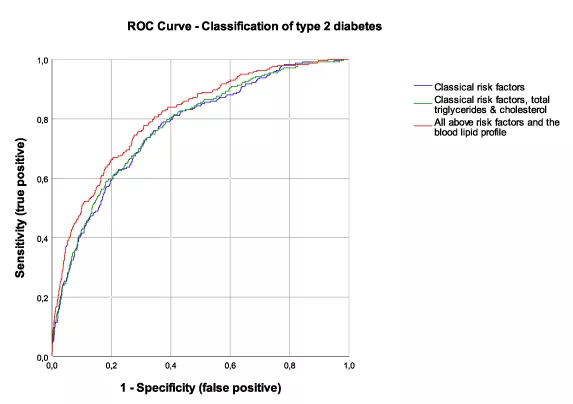“In healthcare, the total amounts of cholesterol and triglycerides are measured, not the exact composition of the classes. One class consists of several molecules and in our study we can see that it is good to have more of certain blood lipid molecules and less of others, and that these can be linked to lifestyle”, says Céline Fernandez, associate professor of Integrative Molecular Medicine at Lund University, who carried out the study in cooperation with the company Lipotype and the National Bioinformatics Infrastructure Sweden (NBIS).
“Lipidomics links imbalances in lipid metabolism at a molecular level to physiological differences – helping us to predict type 2 diabetes”, says Dr Christian Klose, head of the R&D department at Lipotype.
The study involved the analysis of 178 lipids in blood from 3 668 healthy participants in the Malmö Diet and Cancer study. The participants were divided at random into two equally large groups, group A and B. In addition to blood samples, the study is based on self-reported data about physical activity and diet. In a follow-up just over 20 years later, around 250 in each group had developed type 2 diabetes.
Using machine learning, the researchers could draw up a blood lipid profile in group A based on the concentration of 77 lipid molecules linked to the risk of developing type 2 diabetes later in life. The blood lipid profile’s capability to distinguish individuals who develop type 2 diabetes from those who remain healthy was examined and later confirmed in group B.
A risk analysis based on the known risk factors (age, gender, weight, blood sugar, smoking and blood pressure) was carried out to ascertain whether the blood lipid profile could improve the risk assessment. Adding the total amounts of cholesterol and triglycerides did not improve the risk assessment. However, when the researchers added the specific blood lipid profile instead, the risk prediction improved in a statistically significant way.
Furthermore, the blood lipid profile in itself could better predict the risk of developing type 2 diabetes than obesity, which is considered to be the most important risk factor for type 2 diabetes.
“This means that we could produce a better assessment of who had a high risk of developing type 2 diabetes”, says Celine Fernandez.
Nikolay Oskolkov, bioinformatics specialist at NBIS adds: “This shows how machine learning can be used to improve clinical diagnosis”.
The findings also revealed that the blood lipid profile can be linked to lifestyle. The more that participants exercised in their free time, the smaller the amount of harmful blood lipid profile they had. According to the study, coffee was also linked to a reduced amount of the harmful blood lipid profile. Dairy products, sugar-sweetened drinks and processed meat, on the other hand, were linked to larger amounts of the harmful blood lipid profile.
This indicates that it could be possible to modify your blood lipid profile and thereby your risk of developing type 2 diabetes through lifestyle changes, comments Céline Fernandez. However, further research is needed to confirm this.
One strength of the study is that the researchers could repeat the group A results in group B and thereby validate and confirm the results in other individuals. This was possible because the Malmö Diet and Cancer study has many participants and the blood lipid analysis is so robust.
“One weakness, of course, is that all individuals in the cohort have a similar origin. We don’t know what the results would have been in another cohort, from another part of the world, for example”, concludes Céline Fernandez.
Publication: Plasma Lipidome and Prediction of Type 2 Diabetes in the Population-Based Malmö Diet and Cancer Cohort



